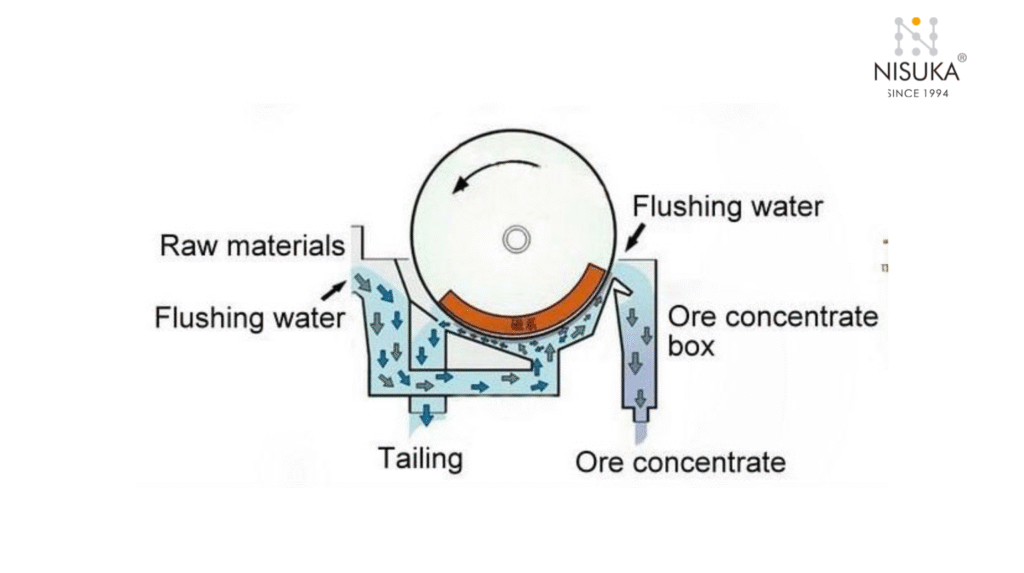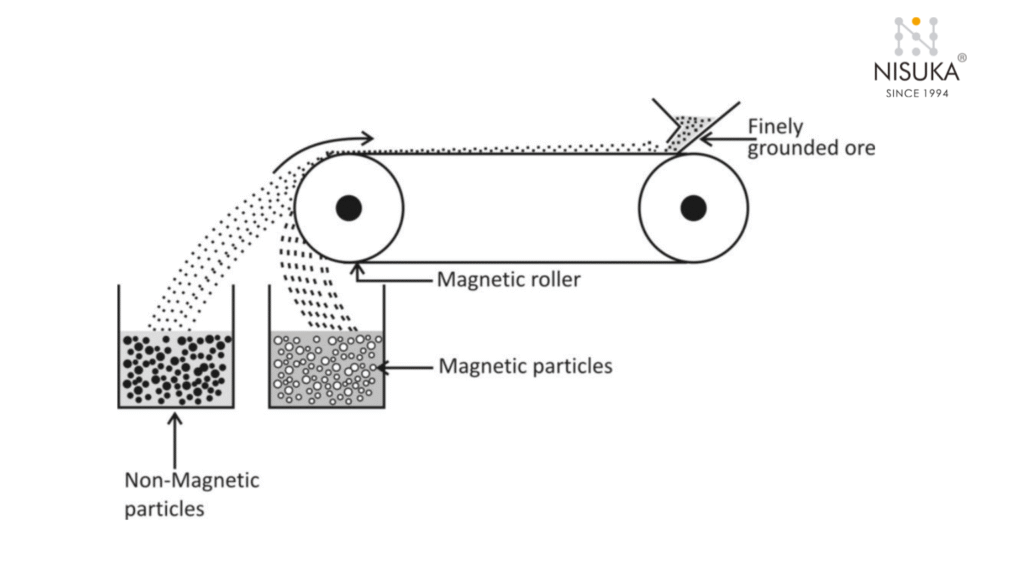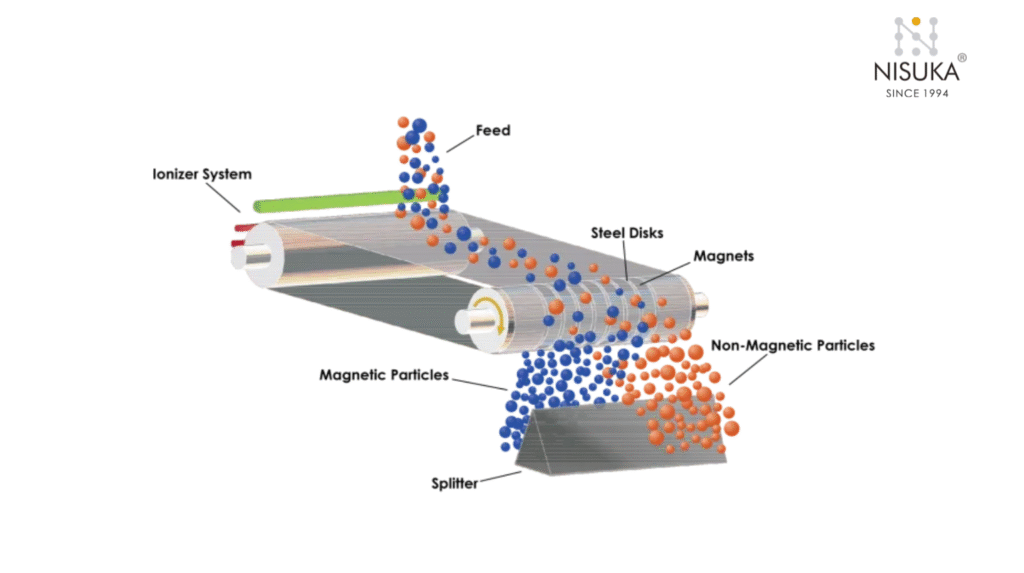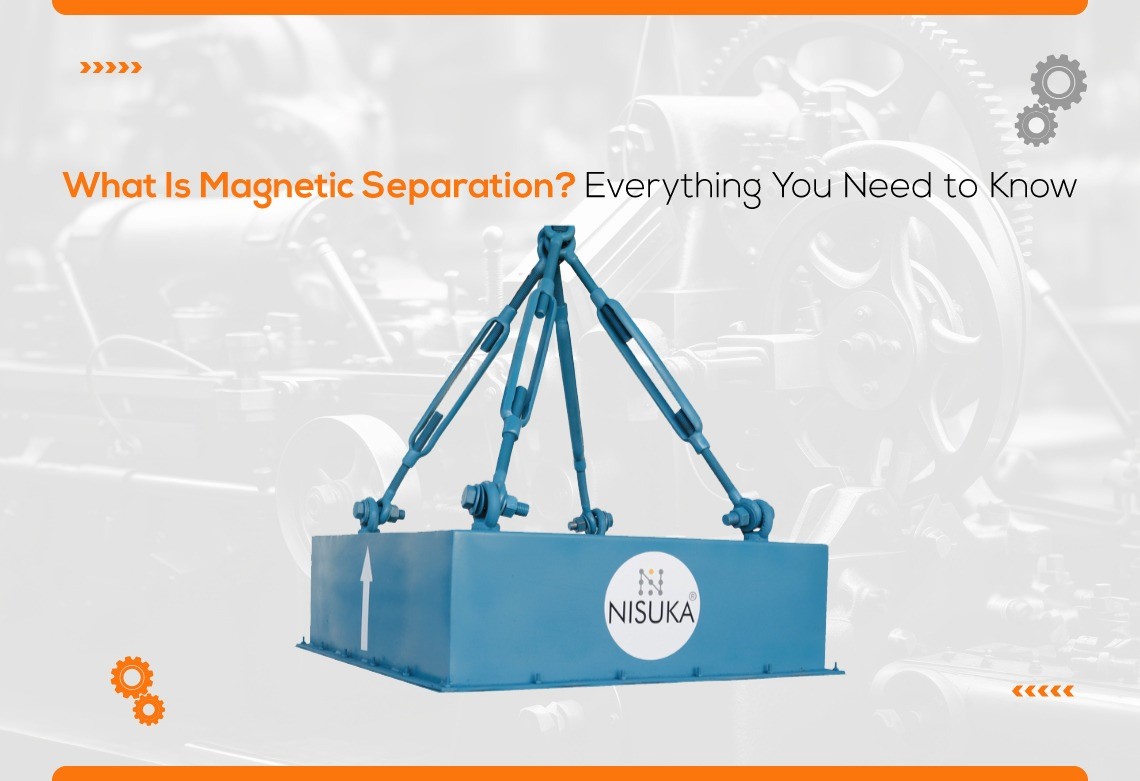What Is Magnetic Separation? Everything You Need to Know
In today’s fast-paced industrial world, maintaining product purity and operational efficiency is more critical than ever. Whether it’s a recycling plant, a mining site, or a food processing unit — one technology plays a silent yet powerful role in ensuring quality: Magnetic Separation.
Magnetic separation is a process that uses magnetic force to extract ferrous metals from raw materials or production lines. It’s one of the oldest and most trusted techniques in material processing, helping industries remove metal contaminants, protect equipment, and improve overall product quality. From magnetic separators in conveyor belts to advanced high-gradient systems, this method has evolved into a cornerstone of modern industrial engineering.
In this blog, you’ll learn what magnetic separation is, how it works, the different types of magnetic separators, and where it’s used across industries. We’ll also explore its advantages, applications, and future innovations shaping the next generation of magnetic technology.
Whether you’re a plant manager, engineer, or student, this guide will give you a complete, expert-level understanding of magnetic separation and its industrial importance—all explained in simple, actionable terms.

What Is Magnetic Separation?
Magnetic separation is a process used to remove metal or magnetic particles from raw materials using magnetic force. It works on the simple principle that magnetic materials are attracted by a magnet, while non-magnetic materials remain unaffected. This method helps industries separate valuable metals or remove unwanted iron particles from products such as grains, minerals, or recycled materials.
In modern industries, magnetic separators are installed in conveyor belts, production lines, and processing machines to ensure product purity and protect equipment from metal damage. The technology plays a crucial role in mining, recycling, food processing, and chemical industries, where even a small metal impurity can cause costly damage or product rejection.
Understanding What Is Magnetic Separation? is essential for engineers and manufacturers who aim to improve quality, efficiency, and safety in material handling systems. The process is not only reliable but also energy-efficient, making it one of the most trusted separation techniques worldwide.
Why Magnetic Separation Is Important in Industries
Magnetic separation is important in industries because it ensures clean, safe, and high-quality production. In sectors like mining and food processing, even small traces of iron or steel can damage machinery, contaminate final products, or reduce overall efficiency. By using magnetic separators, companies can easily remove these metal contaminants before they cause harm.
This process also helps in recycling plants, where separating ferrous metals from waste materials allows for better resource recovery and cost savings. Additionally, magnetic separation supports environmental safety by reducing industrial waste and promoting the reuse of valuable metals.
Industrial experts, including those working with heavy-duty components such as a Plummer block manufacturer, often integrate magnetic separation systems into their processes to maintain machine health and product reliability. In short, What Is Magnetic Separation? is not just a technical process—it’s a vital step toward cleaner, safer, and more sustainable manufacturing operations.
Types of Magnetic Separators
There are several types of magnetic separators designed to remove metal impurities from raw materials in different industries. Each type works on the same magnetic principle but varies in structure, application, and strength. Understanding the Types of Magnetic Separators helps industries choose the right one for their specific needs — whether it’s for recycling, mining, food processing, or bulk material handling.
These separators not only ensure cleaner products but also protect machinery from metal damage, improve product quality, and increase efficiency. Let’s explore the most common types of magnetic separators used in modern industrial applications.
Drum Magnetic Separator

A drum magnetic separator is one of the oldest and most widely used designs. It consists of a rotating drum with a fixed magnetic field inside. As materials pass through the drum, magnetic particles are attracted and held to the surface while non-magnetic materials fall away.
This type is commonly used in mining and mineral processing plants to recover iron or magnetite from ores. It is also ideal for separating fine ferrous materials in recycling and chemical industries. Drum magnetic separators are valued for their continuous operation, high capacity, and low maintenance needs.
Overband and Suspended Magnets
Overband and suspended magnets are designed to remove tramp metals from conveyor belts and bulk materials. They are positioned above the conveyor, where they lift and remove metal contaminants before they reach critical machinery.
Overband magnets usually feature a self-cleaning belt that automatically removes trapped metals, while suspended magnets require manual cleaning. Both types are widely used in recycling plants, cement factories, and coal handling systems.
A trusted suspension magnet manufacturer can customize these magnets based on belt width, load capacity, and operational conditions to ensure maximum efficiency.
Eddy Current Separator
An eddy current separator is used to separate non-ferrous metals such as aluminum, copper, and brass from other materials. It works using a powerful magnetic rotor that generates an alternating magnetic field. When conductive metals pass through this field, they experience a repulsive force that throws them away from the non-metallic stream.
This technology is especially important in recycling and waste management industries, where it helps recover valuable non-ferrous metals for reuse. Eddy current separators promote sustainability and cost savings by reducing waste and increasing resource recovery.
High-Gradient Magnetic Separator (HGMS)
The High-Gradient Magnetic Separator (HGMS) is a highly advanced magnetic separation system. It uses extremely strong magnetic fields and fine wire matrices to capture even the smallest magnetic particles from fluids or powders.
HGMS systems are mostly used in chemical, pharmaceutical, and mineral industries where precise separation is critical. They are efficient in removing weakly magnetic materials like hematite, ilmenite, and rare earth minerals. This technology ensures high product purity and is ideal for fine particle separation tasks.
Wet vs. Dry Magnetic Separation
The wet and dry magnetic separation methods differ mainly in how materials are processed.
- Wet magnetic separation is used when materials are mixed with water or slurry, helping improve separation accuracy for fine particles.
- Dry magnetic separation, on the other hand, is best for materials with low moisture content, such as crushed ore or dry powders.
Choosing between wet and dry methods depends on the type of material, desired purity, and operational setup. Both are essential types of magnetic separators that play a major role in modern industries, from mineral processing to metal recycling.
How a Magnetic Separator Works

Understanding how a magnetic separator works is essential to appreciate its role in removing unwanted metal contaminants from raw materials. At its core, a magnetic separator uses a strong magnetic field to attract and capture ferrous particles — such as iron, steel, and other magnetic materials — while allowing non-magnetic materials to continue their flow.
The process begins when mixed materials pass near or through a magnetic source. Depending on the design, the separator can use permanent magnets or electromagnets to generate the magnetic force. As the mixture flows through, the magnetic field pulls in metal contaminants and holds them until they are automatically or manually removed. This ensures cleaner, safer, and higher-quality materials for industrial use.
In simple terms, how a magnetic separator works can be broken down into three stages:
- Attraction – Magnetic materials are drawn toward the magnetic field.
- Separation – Non-magnetic materials move away, leaving behind the ferrous particles.
- Collection – The trapped metals are collected and removed, keeping the production line free from contamination.
Different types of separators, such as drum, overband, or eddy current systems, work on the same principle but vary in design and strength depending on the application. Industries like mining, recycling, food processing, and pharmaceuticals rely heavily on this technology to maintain product purity and equipment safety.
For example, in a conveyor system, a magnetic separator can be installed above or below the belt to continuously extract metal debris without interrupting the material flow. This efficiency reduces downtime and improves productivity — a critical factor in heavy-duty industries.
Manufacturers also ensure precision alignment and durability of these separators using quality mechanical components, often supported by trusted suppliers like a UCP Pillow block manufacturer, which provides essential bearing housings for smooth, long-term machine operation.
In short, how a magnetic separator works is all about using magnetic power to separate, protect, and purify — making it one of the most vital technologies for modern industrial processing and safety.
Applications of Magnetic Separators
The applications of magnetic separators span across a wide range of industries where removing metal impurities and ensuring product purity are critical. These devices are vital for protecting machines, improving product quality, and maintaining smooth production flow.
One of the most common applications of magnetic separators is in the mining and mineral industry, where they help extract magnetic materials like iron and magnetite from ores. They are also used in recycling plants to separate ferrous metals from non-metallic waste, allowing valuable metals to be recovered and reused efficiently.
In the food processing industry, magnetic separators play a key role in removing metal fragments from products such as grains, flour, sugar, and spices — ensuring consumer safety and compliance with food safety standards. Similarly, in pharmaceutical and chemical industries, they are used to prevent contamination and maintain high-quality standards during material handling and packaging.
Another significant use is found in cement, power, and steel plants, where separators are installed on conveyor belts to remove tramp metal from bulk materials like coal, clinker, or limestone. This prevents equipment damage and costly downtime, helping maintain consistent productivity.
The applications of magnetic separators also extend to automotive, ceramics, and plastic industries, where metal-free raw materials are essential for achieving smooth surface finishes and defect-free products.
For businesses operating complex machinery, it’s also important to combine efficient material separation with proper equipment upkeep. Following Industrial Gearbox Maintenance Tips can further enhance machine reliability and performance, ensuring separators and other mechanical systems run efficiently over time.
In summary, the applications of magnetic separators are diverse and indispensable across modern industries. From mining to manufacturing, these devices safeguard equipment, improve product quality, and contribute to a cleaner, safer production environment — making them one of the most valuable tools in today’s industrial processes.
Advantages of Magnetic Separation

The advantages of magnetic separation make it one of the most efficient and reliable methods for removing metal contaminants from various materials. This technology offers multiple benefits that help industries improve product quality, ensure equipment safety, and enhance operational efficiency.
One of the key advantages of magnetic separation is its high precision and effectiveness. Magnetic separators can easily detect and remove even the smallest ferrous particles, ensuring that the final product is clean and contamination-free. This is especially important in food, pharmaceutical, and chemical industries, where purity and safety standards are strict.
Another major benefit is cost-efficiency. Once installed, magnetic separators require minimal energy and maintenance. They can operate continuously without frequent downtime, reducing labor costs and increasing overall productivity. This makes them an ideal long-term investment for large-scale production facilities.
Environmental protection is another important advantage of magnetic separation. By recovering and recycling metal waste, industries can minimize landfill disposal and promote sustainability. This contributes to a cleaner environment and supports eco-friendly manufacturing practices.
Additionally, magnetic separation enhances equipment life. By removing metal debris from raw materials, it prevents machinery from wear and tear, reducing the need for frequent repairs. This benefit is particularly valuable in heavy-duty sectors such as mining, cement, and recycling, where machine reliability is crucial.
Industrial systems that integrate magnetic separators often pair them with high-quality mechanical components from trusted suppliers like an SMSR Gearbox manufacturer, ensuring smooth power transmission and stable operation across the production line.
In summary, the advantages of magnetic separation include superior accuracy, cost savings, reduced equipment damage, and environmental benefits. It is a clean, efficient, and dependable process that plays a vital role in maintaining product quality and operational excellence across multiple industries.
Conclusion
In conclusion, Magnetic Separation stands as one of the most powerful and reliable technologies for removing metal contaminants and ensuring product purity across industries. From mining and recycling to food processing and pharmaceuticals, its role in maintaining safety, efficiency, and quality is unmatched.
Understanding how a magnetic separator works, its various types, and the applications of magnetic separators helps businesses choose the right equipment for their needs. The advantages of magnetic separation — including cost-effectiveness, high precision, environmental sustainability, and machinery protection — make it an essential process in modern industrial operations.
As industries continue to innovate, integrating high-quality equipment from trusted engineering partners such as gearbox and magnet system manufacturers ensures consistent performance and reliability. Magnetic separation is not just a filtration method; it’s a long-term investment in cleaner production, sustainable resource use, and improved operational excellence.
With the right setup and maintenance, this simple yet effective technology continues to play a major role in shaping safer, smarter, and more sustainable industrial processes worldwide.
FAQS
What materials can Magnetic Separation remove?
Magnetic Separation removes ferrous metals like iron, steel, and magnetite. It also works for weakly magnetic materials such as hematite or pyrrhotite. However, it cannot separate non-magnetic substances like aluminum, copper, or glass.
What is the difference between permanent and electromagnetic separators?
Permanent magnetic separators use fixed magnets that require no power, while electromagnetic separators use an electric current to create a magnetic field. Electromagnetic designs offer adjustable strength for precise metal removal in heavy industrial applications.
How strong is the magnet used in Magnetic Separators?
The strength of magnets in Magnetic Separators ranges from 1,000 to over 20,000 gauss. The required magnetic force depends on the application — stronger magnets are used for fine particles or weakly magnetic materials.
Can Magnetic Separators separate non-ferrous metals?
Standard magnetic separators cannot remove non-ferrous metals like aluminum or copper. For that, industries use eddy current separators, which generate a repelling magnetic field to push non-ferrous metals away from non-conductive materials.
What is the lifespan of a Magnetic Separator?
A well-maintained Magnetic Separator can last for over 10 years. Regular inspection, cleaning, and magnet strength testing are essential to ensure consistent performance and prevent contamination or decreased magnetic efficiency.
Are Magnetic Separators energy efficient?
Yes. Magnetic Separators are highly energy efficient because most types, especially permanent magnet systems, operate without continuous power. Even electromagnetic models consume minimal energy compared to other separation or filtration technologies.
Can Magnetic Separators be customized for specific industries?
Absolutely. Magnetic Separators can be customized based on industry type, material flow, particle size, and installation setup. Leading manufacturers design tailored solutions for industries like food, recycling, mining, and pharmaceuticals.

